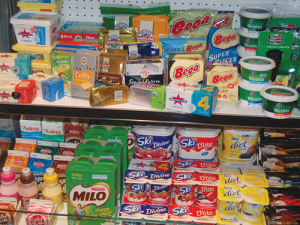Revamped Fonterra to be ‘more capital-efficient’
Fonterra chair Peter McBride says the divestment of Mainland Group is their last significant asset sale and signals the end of structural changes.
 Fonterra says it will become the first global dairy processor to have farm-to-fork electronic traceability.
Fonterra says it will become the first global dairy processor to have farm-to-fork electronic traceability.
Fonterra is on track to become the first global dairy processor to have farm-to-fork electronic traceability.
By 2020 the co-op’s 11,000 supplier farms around the world would be part of the system; any product concerns will be traced anywhere on the supply chain within three hours.
The world-class traceability standards will extend to Fonterra’s 140 plants at 50 sites in nine countries, in seven languages and involving 2000 unique food items.
Already, all New Zealand and Australian-sourced products, representing 74% of total global production, can be electronically traced through the supply chain from manufacturing sites to customers.
While the co-op is not divulging how much the traceability system will cost, Fonterra’s general manager trust in source, Tim Kirk, says the cost pales in comparison to “what we will deliver”.
“It’s a substantial investment by Fonterra,” Kirk told Rural News.
“What we are aiming for now is world-class electronic product traceability, so if we have any concerns about any product we can electronically trace it anywhere in our supply chain within three hours,” says Kirk.
“We are well advanced. By the end of this year 40% of our plants globally will have traceability data electronically connected, a further 50% of the plants will be included by the end of 2017, and the remaining 10% will be completed in 2018-19.”
Indonesia and Malaysia are the next two countries in line to join the scheme.
Fonterra chief operating officer global consumer and foodservice Jacqueline Chow says the scheme will make it possible “to electronically trace the goodness in every drop of milk our farmers produce and the products we make from it, so traceability will extend back to milk off farms.
“Today as more products cross borders and consumers put more store in the value of good nutrition, there is a growing demand for information about what goes into our food and for reassurance that it is produced with great care. Traceability provides consumers with reassurance.”
She says Fonterra has always been able to trace products, but through systems using a mix of electronic information, manual logs and spreadsheets.
Kirk says the versatility of milk and Fonterra’s scale as the world’s largest dairy processor and exporter has required a broad scope for full electronic product traceability.
“Often, components extracted from milk during the making of one product will be added to milk being turned into another product. So as well as tracing finished products, our total product traceability has to cover all the various component products we produce and either sell or use.”
He says that with Fonterra collecting at least 22 billion litres of milk from 10,500 farmers and operating 34 sites in NZ alone, the scale of the job has been huge.
“In ingredients alone, we produce almost 1400 products and we have significant backroom manufacturing and supply chain process technology which is all part of this work.”
Fonterra has adopted the GS1 global traceability standard which defines a minimum set of requirements in business processes to achieve full electronic supply chain traceability. Also being adopted are product authentication, tamper-evident packaging and anti-counterfeiting technology.
“For example we use tamper-evident seals on packaging of all Anmum products in NZ and Indonesia, giving consumers a visible indication of product tampering that could occur post-packing.”
The National Wild Goat Hunting Competition has removed 33,418 wild goats over the past three years.
New Zealand needs a new healthcare model to address rising rates of obesity in rural communities, with the current system leaving many patients unable to access effective treatment or long-term support, warn GPs.
Southland farmers are being urged to put safety first, following a spike in tip offs about risky handling of wind-damaged trees
Third-generation Ashburton dairy farmers TJ and Mark Stewart are no strangers to adapting and evolving.
When American retail giant Cosco came to audit Open Country Dairy’s new butter plant at the Waharoa site and give the green light to supply their American stores, they allowed themselves a week for the exercise.
Fonterra chair Peter McBride says the divestment of Mainland Group is their last significant asset sale and signals the end of structural changes.

OPINION: Your old mate welcomes the proposed changes to local government but notes it drew responses that ranged from the reasonable…
OPINION: A press release from the oxygen thieves running the hot air symposium on climate change, known as COP30, grabbed your…